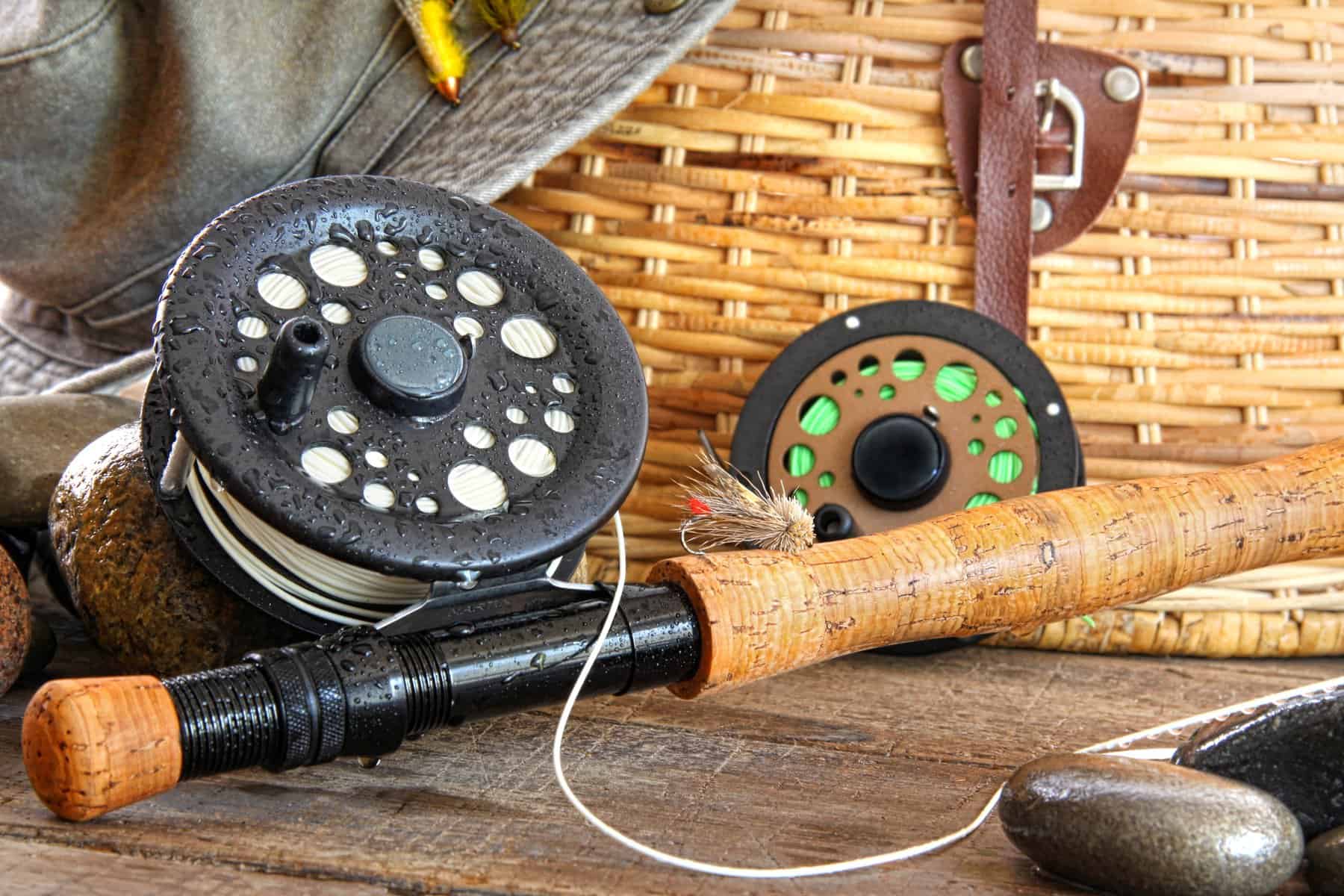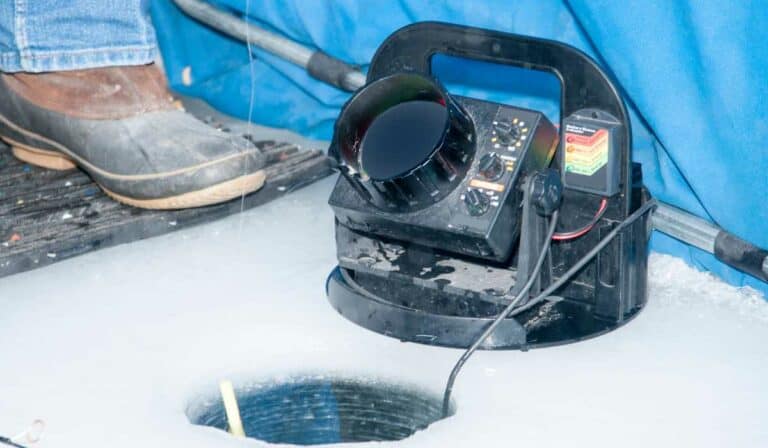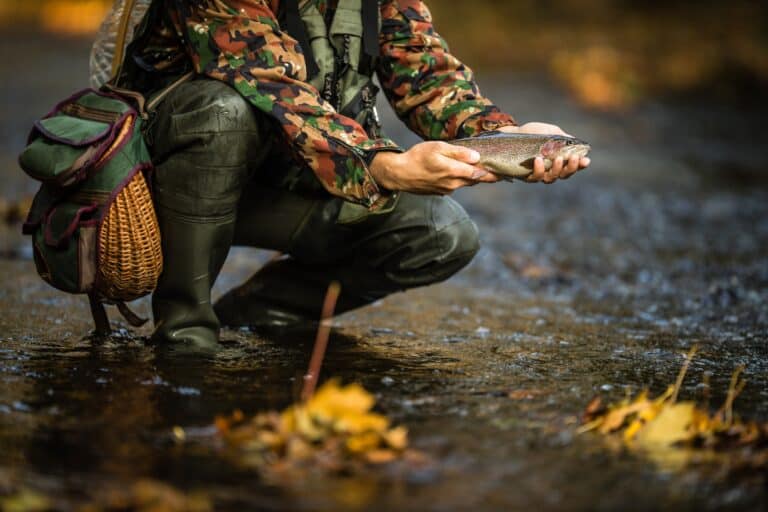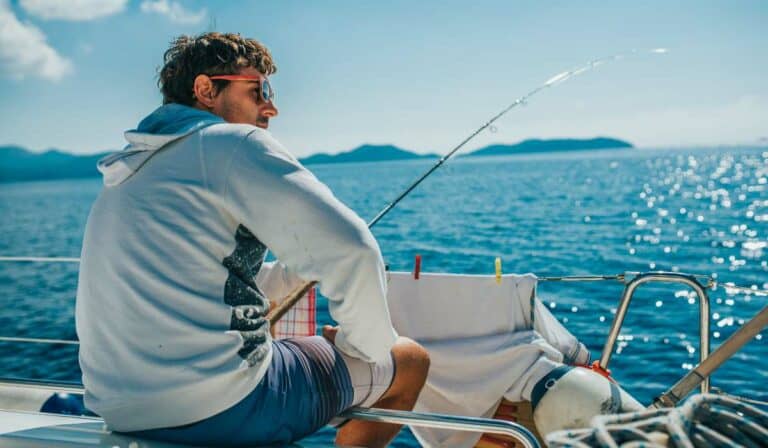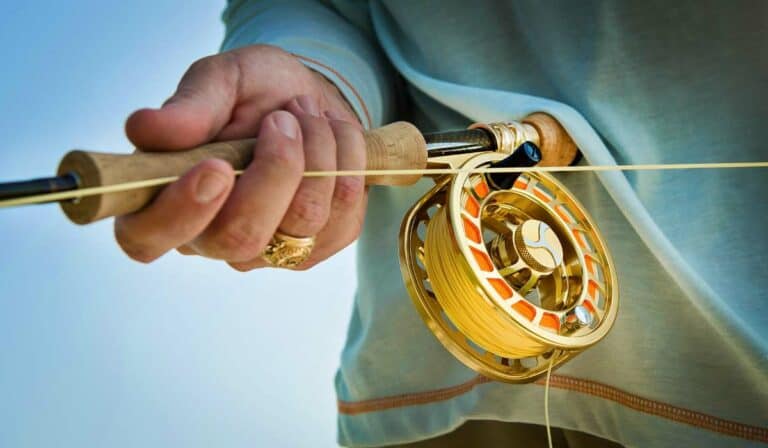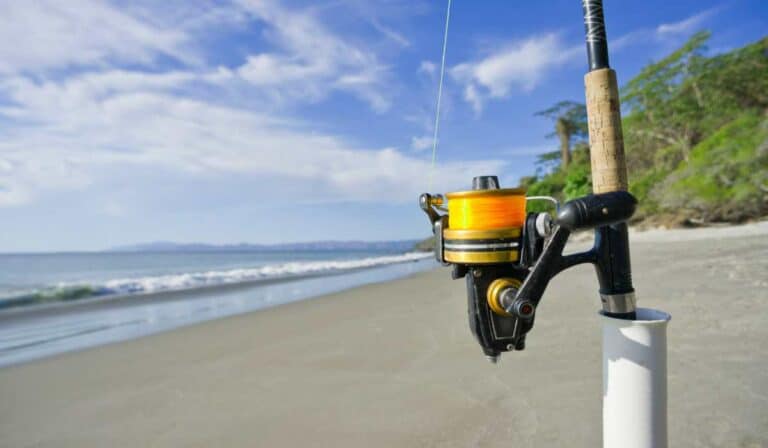Best Fly Fishing Tools For 2023
Discovering the best fly fishing tools can significantly enhance your experience on the water. In this guide, we will delve into various aspects of fly fishing gear and provide expert insights for both beginners and seasoned anglers.
We’ll start by discussing how to choose the perfect fly rod tailored to your needs and preferences. Next, we’ll explore the best reels available to help you reel in your next big catch. We will then discuss essential fly lines that are crucial for a successful day out on the water.
Moving forward, our focus will shift towards indispensable accessories such as wading boots, nippers nippers, slick scissor clamps and more – all designed to make your angling adventures seamless and enjoyable. Additionally, we’ll share valuable tips on selecting flies suitable for various conditions while also offering advice on catching fish with a fly rod effectively.
Last but not least, proper care and maintenance of your prized fly fishing gear are vital in prolonging their life span; hence we’ll cover some practical ways you can look after your cherished gear. So let’s embark upon this journey together as we unravel everything there is to know about acquiring only the best fly fishing tools!
Table of Contents:
- Choosing the Right Fly Fishing Rod
- Best Fly Fishing Reels
- Essential Fly Fishing Line
- Necessary Fly Fishing Accessories
- Best Flies for Fly Fishing
- Tips for Catching Fish with a Fly Rod
- How to Care for Your Fly Fishing Gear
- FAQs in Relation to Best Fly Fishing Tools
- Conclusion
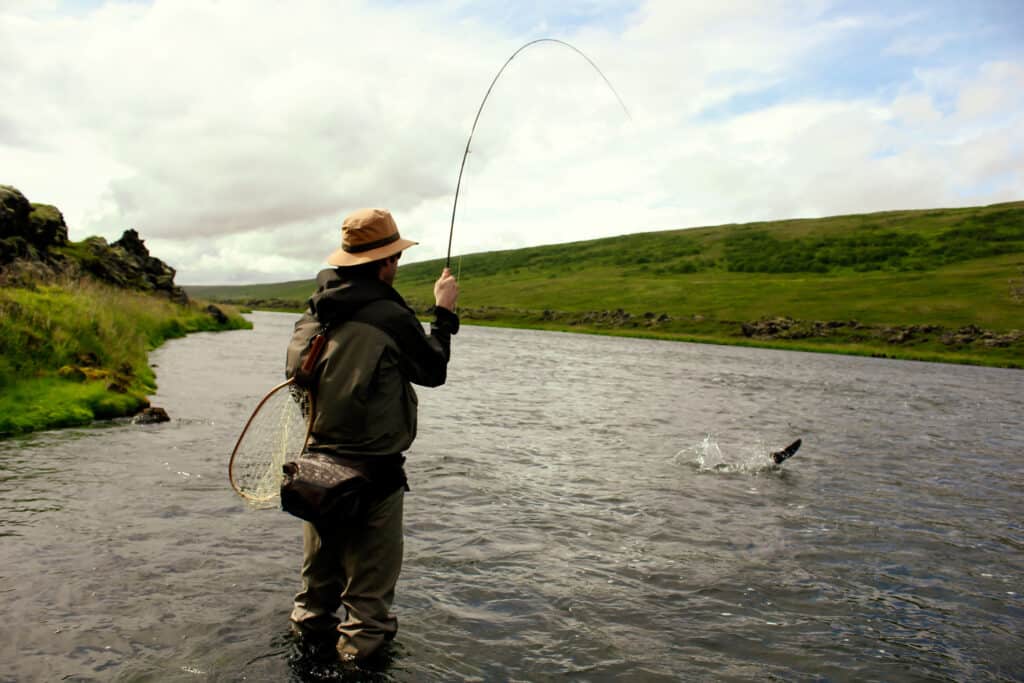
1. Choosing the Right Fly Fishing Rod
Selecting the ideal fly fishing rod can be a challenging undertaking, especially with so many options accessible in the market today. However, by understanding your needs and preferences, you’ll be able to select a rod that will enhance your fly fishing experience and help you reel in those trophy catches.
Length of the Rod
The length of a fly fishing rod is crucial for casting accuracy and distance. Generally speaking, rods range from 6 feet to 10 feet in length. Shorter rods (6-8 feet) are ideal for small streams or tight spaces where precision is key. On the other hand, longer rods (9-10 feet) provide better control over line mending and are suitable for larger rivers or lakes.
Rod Material
Fly fishing rods come in various materials such as graphite, fiberglass, bamboo, or even composite blends. Graphite rods are popular due to their lightweight nature and sensitivity; however, they tend to be more expensive than other options like fiberglass which offers durability at an affordable price point.
Action & Flexibility
- Fast Action: These types of rods have stiffer blanks that bend primarily near the tip when loaded during casting – offering greater power but less feel compared to slower action alternatives.
- Moderate Action: A moderate action rod provides a balance between power and flexibility – making it versatile enough for most situations encountered while fly fishing.
- Slow Action: Slow action rods offer maximum flexibility throughout their entire length – allowing anglers better control over their casts and a more delicate presentation of the fly.
Line Weight & Rod Size
The line weight you plan to use should also influence your choice of rod size. For smaller fish species such as trout, a lighter line weight (1-4 wt) is recommended; whereas heavier lines (5-8 wt) are better suited for larger species like bass or salmon. When selecting a rod, it’s essential to choose one that is designed to accommodate the specific line weight you intend on using during your fly fishing adventures.
By considering these factors when choosing your fly fishing rod, you’ll be well-equipped for an enjoyable and successful day out on the water.
Selecting an appropriate fly-fishing rod is critical for a successful and enjoyable angling outing. Once you have determined the right fly fishing rod, it is time to explore options for the ideal reels to suit your needs.
Key Points To Remember:
When choosing a fly fishing rod, consider factors such as length, material, action and flexibility. The line weight you plan to use should also influence your choice of rod size. By selecting the right rod for your needs and preferences, you’ll be able to enhance your fly fishing experience and increase your chances of catching trophy fish.
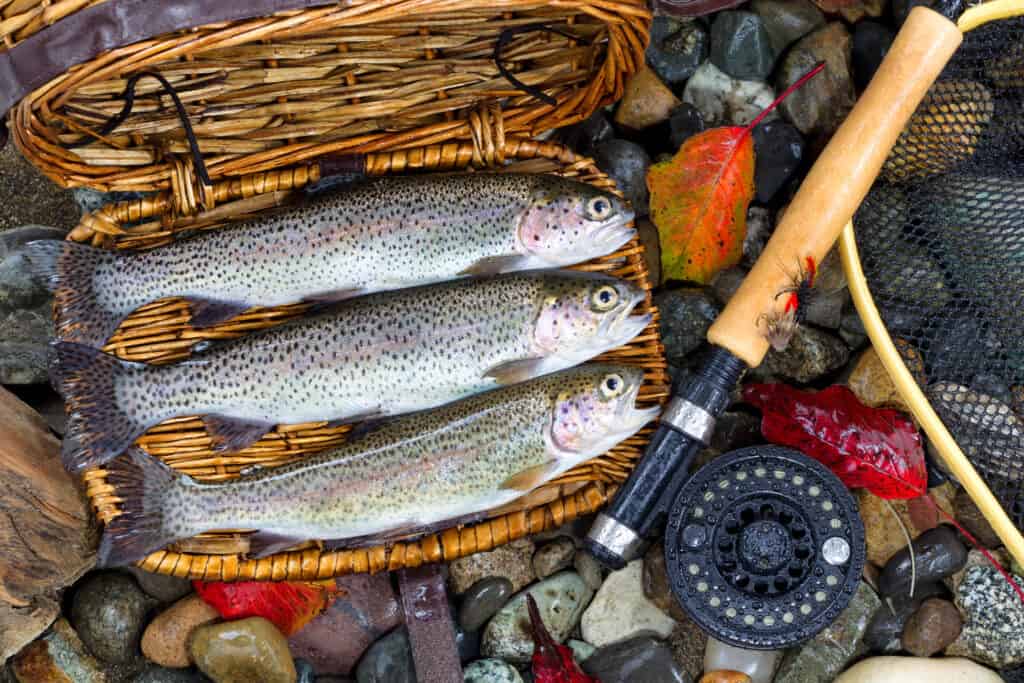
Best Fly Fishing Reels
It can be a daunting task to pick the ideal fly fishing reel from the many available options. In this section, we’ll explore some of the top fly fishing reels on the market and their unique features that make them stand out.
Large Arbor Reels
Large arbor reels are known for their quick line retrieval capabilities and reduced line memory, making them an excellent choice for anglers who value efficiency in their gear. Some popular large arbor reel models include:
- The Orvis Hydros SL Fly Reel – This high-quality reel offers smooth drag performance with minimal start-up inertia.
- Lamson Guru Series II – A lightweight yet durable option that provides exceptional value without sacrificing quality.
- Ross Animas – Designed with durability in mind, this rugged reel features a fully machined aluminum frame and spool to withstand harsh conditions.
Mid-Arbor Reels
Mid-arbor reels strike a balance between traditional standard arbor designs and modern large arbors by offering moderate line retrieval speed while maintaining ample backing capacity. Some top mid-arbor reels include:
- Galvan Torque T-5 – Known for its precision engineering, this American-made reel boasts smooth operation and reliability under pressure.
- Hatch Finatic Gen 2 – This versatile reel is suitable for a variety of fishing situations, with its sealed drag system ensuring consistent performance.
Traditional Standard Arbor Reels
For those who appreciate the classic design and simplicity of traditional standard arbor reels, there are still plenty of great options available. Some noteworthy models include:
- Hardy Perfect – A timeless classic that has been trusted by anglers for over a century, this reel offers exceptional craftsmanship and durability.
- Pflueger Medalist – An affordable option that provides reliable performance without breaking the bank.
When selecting your ideal fly fishing reel, consider factors such as line capacity, retrieval speed, weight balance with your rod, and personal preferences in terms of aesthetics and functionality. By taking these factors into consideration, you can be sure to find the perfect fly fishing reel for your next outing.
Key Points To Remember:
This section discusses the best fly fishing reels for a successful day on the water, including large arbor reels with quick line retrieval and reduced memory, mid-arbor reels that balance traditional and modern designs, and traditional standard arbor reels. Consider factors such as line capacity, weight balance with your rod, and personal preferences to find the perfect reel for your next outdoor adventure.
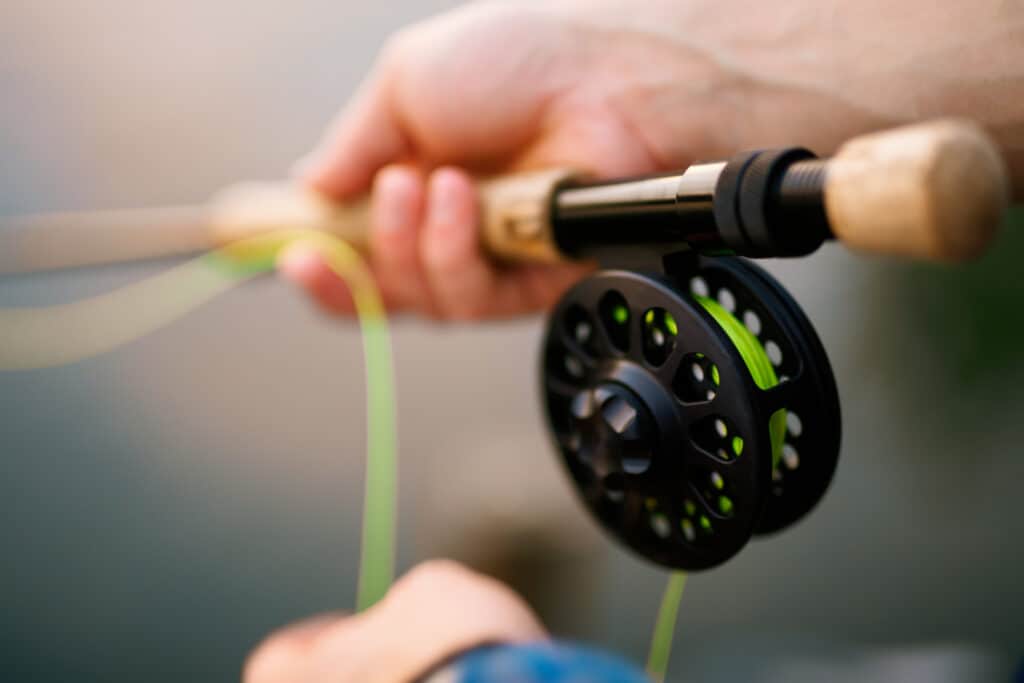
3. Best Fly Fishing Lines
Fly fishing lines are a crucial component of your fly fishing setup, as they play a significant role in casting and presenting the fly to the fish. Choosing the right type of line for your specific situation can greatly enhance your overall experience and success on the water. In this section, we will explore the different types of fly fishing lines and their appropriate applications.
Weight Forward (WF) Lines
Weight forward (WF) lines are among the most popular choices for many anglers due to their versatility and ease of use. The front portion of these lines is heavier than the rest, which helps with longer casts and better control when presenting flies at different distances. WF lines work well with both dry flies and nymphs, making them suitable for a wide range of situations.
Double Taper (DT) Lines
Double taper (DT) lines have an even distribution of weight throughout their length, providing excellent presentation capabilities at short to medium distances. These lines are ideal for delicate presentations or when targeting skittish fish that may be spooked by more aggressive casts.
Sinking Tip Lines
If you’re planning on targeting fish that hold deeper in rivers or lakes, sinking tip lines might be just what you need. These specialized fly fishing lines feature a sinking tip section connected to a floating mainline allowing you to reach greater depths while maintaining control of your fly. Sinking tip lines are particularly useful when fishing streamers or nymphs in deeper water.
Floating Lines
As the name suggests, floating lines stay on the surface of the water and are perfect for dry fly fishing or shallow-water nymphing. They offer excellent visibility and control, making them a favorite among beginners and experienced anglers alike.
Selecting The Right Line Weight
- Lighter line weights (1-4): Ideal for small streams with smaller fish species such as trout or panfish.
- Medium line weights (5-7): Suitable for larger rivers and lakes targeting medium-sized fish like bass, carp, or larger trout.
- Heavier line weights (8+): Best suited for big game saltwater species like tarpon, bonefish, or salmon in large rivers.
In summary, choosing the right type of fly fishing line is essential to maximize your success on the water. Consider factors such as casting distance requirements, targeted fish species’ depth preferences, and presentation style before making your decision. With proper research and understanding of different types of lines available on the market today, you’ll be well-equipped to tackle any fly-fishing situation that comes your way.
Key Points To Remember:
Choosing the right fly fishing line is crucial for success on the water. Weight forward lines are versatile and easy to use, while double taper lines provide excellent presentation capabilities at short to medium distances. Sinking tip lines allow you to reach greater depths when targeting fish that hold deeper in rivers or lakes, and floating lines are perfect for dry fly fishing or shallow-water nymphing.
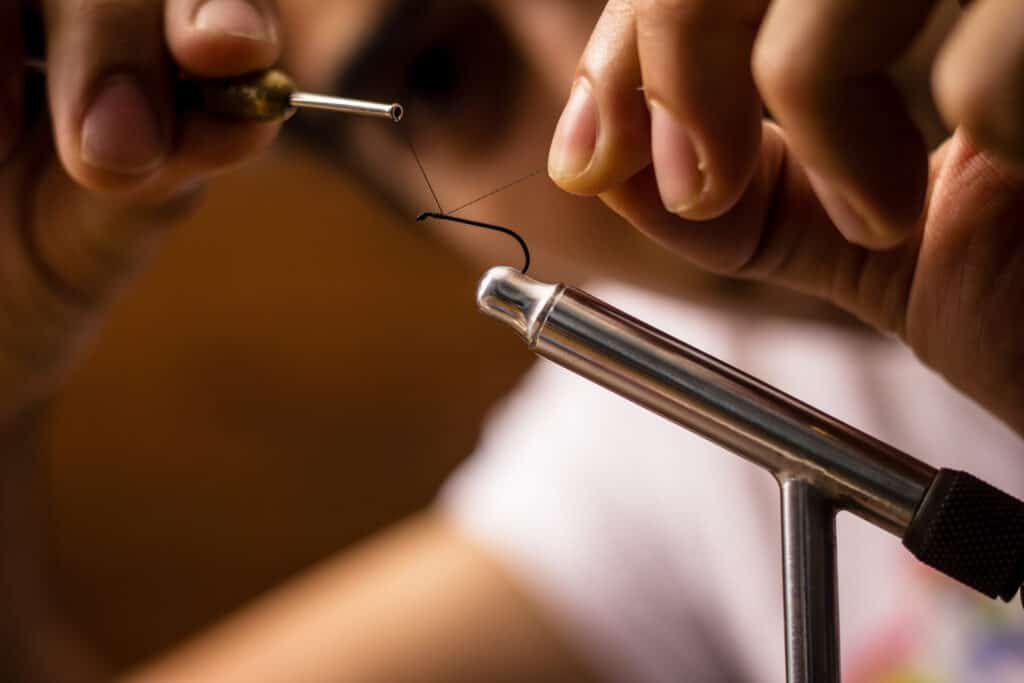
4. Necessary Fly Fishing Accessories
Embarking on a fly fishing adventure requires not only the right rod, reel, and line but also some essential accessories to ensure success and enjoyment. To ensure success and enjoyment on a fly fishing adventure, every angler should equip themselves with the essential accessories mentioned in this section.
A. Fly Box
A fly box is an indispensable accessory for organizing and storing your flies while out on the water. Choose one with compartments or foam inserts to keep your flies secure and easily accessible.
B. Tippet Material
Tippet material is crucial for connecting your leader to your fly, allowing you to present it naturally in the water without spooking fish. Make sure you carry various sizes of tippets suitable for different situations and species.
C. Nippers & Hemostats
Nippers are some of the best fishing tools to have. They are used for cutting excess line or trimming knots during rigging while hemostats help remove hooks from fish’s mouths safely without harming them or yourself. Check out these recommended nippers and hemostats.
- Nippers: A good pair of nippers should be sharp enough to cut through any type of fishing line quickly.
- Hemostats: Opt for a quality pair made from stainless steel with serrated jaws that can grip hooks firmly even when wet.
D. Wading Gear
To ensure a pleasant and dry fishing experience, invest in robust, breathable waders and boots. Look for high-quality waders made from breathable materials that offer excellent durability and comfort.
E. Fly Fishing Vest or Pack
A fly fishing vest or pack helps keep all your accessories organized and within easy reach during your outing. Choose one with multiple pockets to store everything from flies to tippets, nippers, hemostats, and more. Here’s a list of the best fly fishing vests and packs.
F. Polarized Sunglasses & Hat
Polarized sunglasses protect your eyes from harmful UV rays while reducing glare on the water surface so you can spot fish easily. A hat provides additional protection against sunburns by shielding your face from direct sunlight exposure.
Incorporating these necessary fly fishing accessories into your gear will not only make each trip more enjoyable but also increase your chances of catching fish on the water.
Having the right accessories is essential to successful fly fishing. With the necessary gear in hand, you are now ready to explore what type of flies will be best for your next outing.
Key Points To Remember:
To ensure success and enjoyment on a fly fishing adventure, it’s important to have the necessary accessories such as a fly box for organizing flies, tippet material for connecting leader to fly, nippers and hemostats for rigging and hook removal, wading gear for comfort in rivers or streams, a vest or pack with multiple pockets for easy access to all accessories, polarized sunglasses and hat. These essential tools will increase your chances of catching fish while making each trip more enjoyable.
5. Best Flies for Fly Fishing
Fly fishing is an exciting and rewarding outdoor activity that requires the right tools, including the perfect flies to catch your target fish species. In this section, we will uncover the top flies used in fly fishing and how to use them effectively.
A. Dry Flies
Dry flies are designed to float on the water’s surface, imitating insects like mayflies, caddisflies, and stoneflies. Dry flies are suited for angling trout and other fish that feed in or near the top of rivers and streams. Some popular dry fly patterns include:
- Parachute Adams
- Elk Hair Caddis
- Blue-Winged Olive (BWO)
B. Wet Flies & Nymphs
Wet flies sink below the water’s surface and can be fished at various depths depending on their weight or added split shot(s). Nymphs represent aquatic insect larvae such as mayfly nymphs or caddis pupae which live underwater before hatching into adult insects above water level. These types of flies are effective in attracting a wide range of fish species due to their versatility in depth control during presentation.
- Bead Head Prince Nymph
- Copper John
- Hare’s Ear Nymph
C. Streamers & Baitfish Imitations
Streamers and baitfish imitations are designed to mimic small fish, leeches, or other large aquatic prey that larger fish species feed on. These flies can be particularly effective when targeting predatory fish such as bass, pike, and even saltwater species like tarpon.
- Woolly Bugger
- Clouser Minnow
- Deceiver Flies Assortment
D. Terrestrial Flies
Terrestrial flies imitate land-based insects such as ants, beetles, grasshoppers or crickets which often end up in the water due to wind or accidents while crossing rivers and streams. These types of flies are especially useful during summer months when terrestrial insects become more active around bodies of water.
- Foam Beetle
- Chernobyl Ant
- Dave’s Hopper
Remember, the key to successful fly fishing is matching your flies to the natural food sources in the water you’re fishing. Experiment with different patterns and presentations until you find what works best for your target species and specific location.
Key Points To Remember:
This section covers the best flies for fly fishing, including dry flies like Parachute Adams and Elk Hair Caddis, wet flies and nymphs such as Bead Head Prince Nymph and Copper John, streamers and baitfish imitations like Woolly Bugger and Clouser Minnow, as well as terrestrial flies such as Foam Beetle. The key to successful fly fishing is matching your flies to the natural food sources in the water you’re fishing.
6. Tips for Catching Fish with a Fly Rod
Fly fishing is an art form that necessitates patience, proficiency and the proper approaches for success. In this section, we will discuss some valuable tips and strategies to help you catch more fish with your fly rod.
A. Perfect Your Casting Technique
One of the most important aspects of fly fishing is mastering your casting technique. To improve your cast, practice different types of casts such as roll casts or sidearm casts in various situations like windy conditions or tight spaces. You can also watch instructional videos from experts like Orvis Fly Fishing on YouTube for guidance.
B. Learn How to Read Water
To maximize success, become familiar with how water flows and the areas where fish tend to congregate for feeding. Study areas where fish are likely to congregate such as pools, riffles, and seams between fast-moving water and slower current zones. This knowledge will help you determine where best to present your flies.
- Pools: Deep slow-moving sections often hold larger fish seeking shelter from predators or resting after feeding in faster currents.
- Riffles: Shallow fast-flowing sections provide oxygen-rich environments attracting insects which attract hungry fish looking for food sources.
- Seams: These transitional zones between two different water speeds offer excellent opportunities for presenting flies since they create natural gathering points for drifting insects.
C. Match the Hatch
“Matching the hatch” refers to selecting a fly that closely resembles the insects that fish are currently feeding on. Observe the types of bugs in and around the water, and choose flies that mimic their size, shape, and color. Websites like Hatch Charts can help you determine which insects are active during specific times of year in your region.
D. Use Proper Fly Presentation Techniques
The way you present your fly to a fish is crucial for success. Some key techniques include:
- Dead Drift: Allow your fly to drift naturally with the current as if it were an actual insect floating downstream.
- Mending Line: Adjusting your line while maintaining a natural drift helps prevent drag caused by currents pulling on it unnaturally.
- Vary Your Retrieve Speeds: Experiment with different retrieval speeds when using streamers or wet flies to imitate various swimming patterns of aquatic life such as minnows or leeches.
By following these tips and continually refining your skills, you’ll be well-equipped for catching more fish during your next fly fishing adventure.
Key Points To Remember:
To catch more fish with your fly rod, perfect your casting technique by practicing different types of casts and watching instructional videos. Learn how to read water to determine where best to present your flies, match the hatch by selecting a fly that closely resembles the insects fish are feeding on, and use proper fly presentation techniques such as dead drift or varying retrieve speeds.
How to Care for Your Fly Fishing Gear
Taking proper care of your fly fishing gear is essential to ensure it lasts longer and performs better on each outing. By following these easy maintenance tips, you can keep your gear in prime condition and have a successful time on the water.
Cleaning Your Fly Rod
After every use, make sure to clean your fly rod by wiping it down with a soft cloth or sponge dampened with fresh water. Wipe the rod down to eliminate any dirt, grime or salt that may have built up while fishing. Make sure to dry the rod thoroughly before storing it away.
Maintaining Your Fly Reel
- Rinse: After each use, rinse off your fly reel with fresh water to remove any debris or saltwater residue.
- Dry: Allow the reel to air-dry completely before putting it back into its storage case.
- Lubricate: Periodically apply a small amount of reel lubricant (available at most outdoor stores) onto the moving parts of the reel according to the manufacturer’s instructions.
- Inspect & Tighten Screws: Regularly inspect all screws and connections on your fly reel for signs of wear or damage; tighten as needed using appropriate tools.
Caring for Your Fly Line & Leader Material
To maintain optimal performance, it’s important to clean and care for your fly line and leader material. Here are some tips:
- Clean the fly line after each use by wiping it down with a soft cloth or sponge dampened in fresh water.
- Occasionally apply a specialized fly line cleaner or conditioner to help maintain its slickness and buoyancy.
- Inspect your leader material regularly for any signs of wear, abrasion, or damage; replace as needed.
Storing Your Fly Fishing Gear Properly
To ensure longevity, always store your fly fishing gear properly when not in use. Follow these guidelines:
- Rod Storage: Store your rod in a protective case or tube, preferably one that is ventilated to allow moisture to escape.
- Fly Reel Storage: Keep the reel inside its storage pouch or case when not attached to the rod; this will protect it from dust and scratches.
- Fly Line & Leader Material Storage: Coil up unused lengths of fly line and leader material neatly before storing them away; avoid kinks by using wide loops while coiling them up.
Taking good care of your fly fishing equipment will prolong its lifespan and enhance its performance on every outing. With proper maintenance, you can enjoy countless adventures exploring planet earth.
Key Points To Remember:
To ensure your fly fishing gear lasts longer and performs better, it’s important to take proper care of it. This includes cleaning your rod and reel after every use, lubricating the moving parts of the reel periodically, inspecting screws for signs of wear or damage, cleaning and caring for your fly line and leader material regularly, and storing all equipment properly when not in use.
FAQs in Relation to Best Fly Fishing Tools
What is the most important fly fishing tool?
The most important fly fishing tool is the fly rod, as it determines your casting ability and overall control when targeting fish. A high-quality rod with the right length, weight, and action will significantly improve your chances of success on the water. Consider factors such as target species and preferred techniques when choosing a suitable rod.
What tools are needed for fly fishing?
Essential tools for fly fishing include a well-matched rod, reel, line setup (including backing), flies or lures specific to targeted species, leaders and tippets of appropriate strength and size. Additionally, you’ll need accessories like nippers or scissors to cut lines, forceps for hook removals from fish mouths or snags in clothing/gear; also consider waders/wading boots if necessary.
What makes a good fly fishing guide?
A good fly fishing guide possesses extensive knowledge about local waters’ ecosystems including fish behavior patterns related to seasonal changes/weather conditions; they should have excellent communication skills teaching beginners while providing valuable insights experienced anglers may not know yet. They must prioritize safety ensuring clients enjoy their experience without risk-related incidents occurring during trips.
Is fly fishing an expensive hobby?
Fly-fishing can be both affordable or expensive depending on personal preferences/choices made regarding gear quality levels purchased initially along with ongoing expenses incurred through replacing consumables (e.g., flies). However, investing wisely upfront ensures long-term enjoyment at reasonable costs considering potential benefits gained – relaxation, mental health boosts, plus physical exercise opportunities offered by this engaging outdoor activity.
If you’re interested in ice fishing, check out our post on the best ice fishing tools.
Conclusion
From choosing the right rod and reel to selecting the best flies and accessories, each component plays an important role in helping you catch more fish.
To ensure you make the most of your fly fishing experience, be sure to follow our tips for catching fish with a fly rod and properly maintain your gear.

